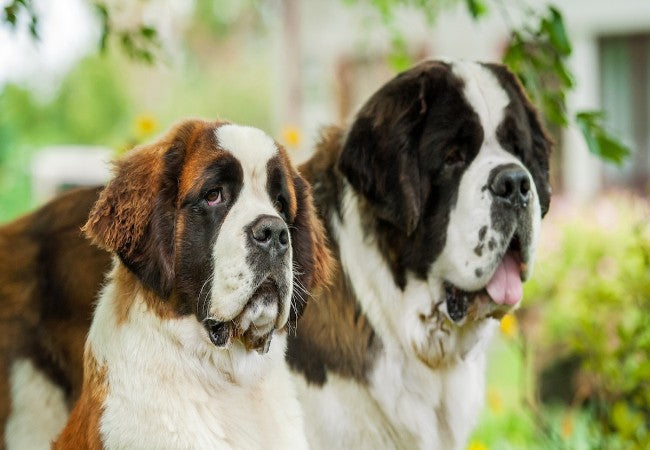Saint Bernard Guide 2025: Vet Approved Heroic Alpine Rescuer ✅🏔️

In this article
Saint Bernard Guide 2025: Vet Approved Heroic Alpine Rescuer ✅🏔️
By Dr. Duncan Houston BVSc
📜 History & Alpine Heritage
The Saint Bernard originated in the Western Alps, bred by monks at the Great St Bernard Hospice between Switzerland and Italy from the 1600s onwards. Famously used in mountain rescue, the legendary Barry saved over 40 travelers in the early 1800s. Though no longer active in rescues, the hospice retains a few for tradition.
🧬 Genetics & Health Screenings
- Size & lifespan: 26–30 in, 120–180 lb; 8–10 years average
- Critical screenings: hips/elbows, cardiac, bloat prevention, polyneuropathy (ARHGEF10), osteosarcoma, dilated cardiomyopathy, eyes, thyroid
- Coat & drool traits: Smooth or rough dense double coat; seasonal shed and slobber management essential
🎭 Temperament & Behavior Insights
Saint Bernards are the epitome of a “gentle giant” — calm, patient, affectionate, and great with children. They’re protective yet not aggressive, often barking only to alert. However, selective breeding has made them more brachycephalic and drool-heavy compared to historical stock.
👪 Family Fit & Lifestyle
- Ideal for families who can accommodate their size and drool level—supervision needed with kids
- Adaptable to homes with gardens or spacious indoors. Low prey drive; good with other pets
- Moderate exercise needs, but requires purposeful daily movement
🏃 Exercise, Training & Enrichment
- Exercise: 45–60 min daily walks or hikes—therapy work or cart-pulling opportunities
- Training: Gentle reward-based methods—focus on recall, calmness, and delayed gratification
🧼 Grooming & Drool Management
- Brush weekly; more during shed seasons—bathe monthly or as required
- Wipe jowls and drool daily, clean ears weekly, trim nails monthly, brush teeth 3×/week
- Monitor for skin intertrigo, hygromas, and ear issues
🍽️ Nutrition & Feeding Advice
Feed large-breed formulas in two to three measured meals to reduce bloat risk. Avoid raised bowls and vigorous exercise around meals. Provide joint supplements, maintain ideal body condition.
🏥 Health & Preventive Care
- Annual vet wellness: joints, cardiac, eyes, skin, thyroid
- Monitor for GDV, orthopedic issues, cardiac signs, and bloat symptoms
- Dental care and vaccines remain critical due to drooling
🎬 Pop Culture & Famous Saint Bernards
- ⭐ Beethoven (1992) & sequels made this breed a beloved cinematic staple
- 😱 Cujo (1983) cast them in a nightmare light—leading to mixed public perception
- 🐕 Cameo in Slapshot (1977) sports classic
- 🎥 Featured in Disney’s Barry of the Great St Bernard (1977), honoring the original rescue hero
- 🧳 Often worn tiny barrels in vintage art—mythic iconography rooted in Alpine legend
🧳 Travel & Climate Suitability
- Travel with harness or a large crate; enjoy road trips
- Handle heat cautiously—offer shade and water, avoid midday sun
- Cold-weather adventurers—a coat adapts well, but shelter is essential
✅ Dr Houston’s Saint Bernard Wellness Checklist
- 📆 Annual screenings: hips, cardiac, eyes, thyroid, neurologic DNA
- 🥣 Measured large-breed diet + joint supplements
- 🏃 Daily moderate exercise + mental tasks
- 🧼 Groom grooming, daily drool wipes, ear/teeth care
- 📱 Use Ask A Vet for signs of bloat, drooling issues, or behavior
🌟 Final Summary & Lifestyle Fit
With their legendary rescue past, gentle nature, and immense devotion, Saint Bernards are perfect for loving families who can manage their size and care needs. Through proper screening, structured training, mental stimulation, and affection, these iconic cuddle giants bring strength and warmth into any home.
Need expert guidance for your Saint Bernard’s health or lifestyle? Visit AskAVet.com or download the Ask A Vet app for 24/7 professional support. 📱🐶






